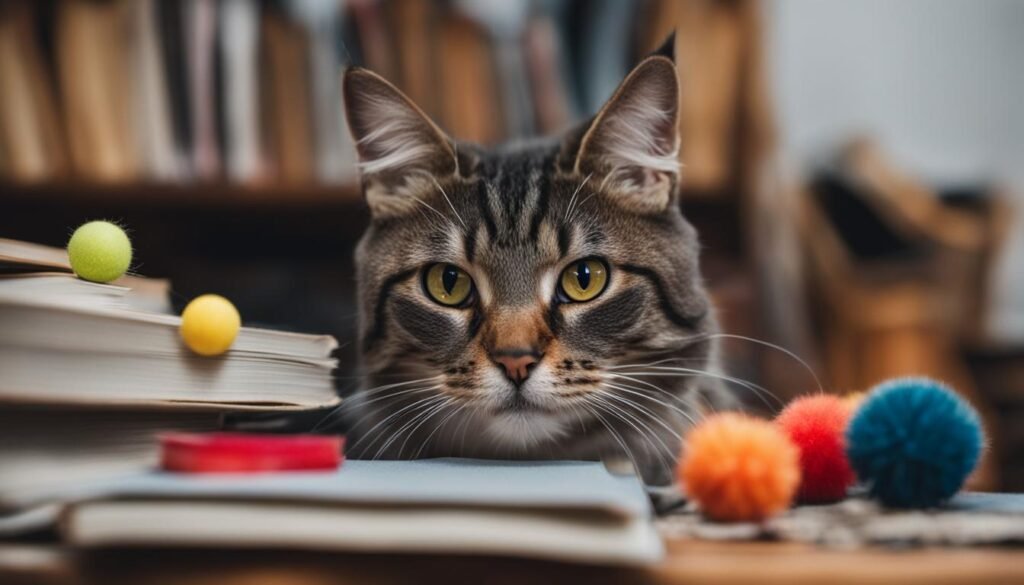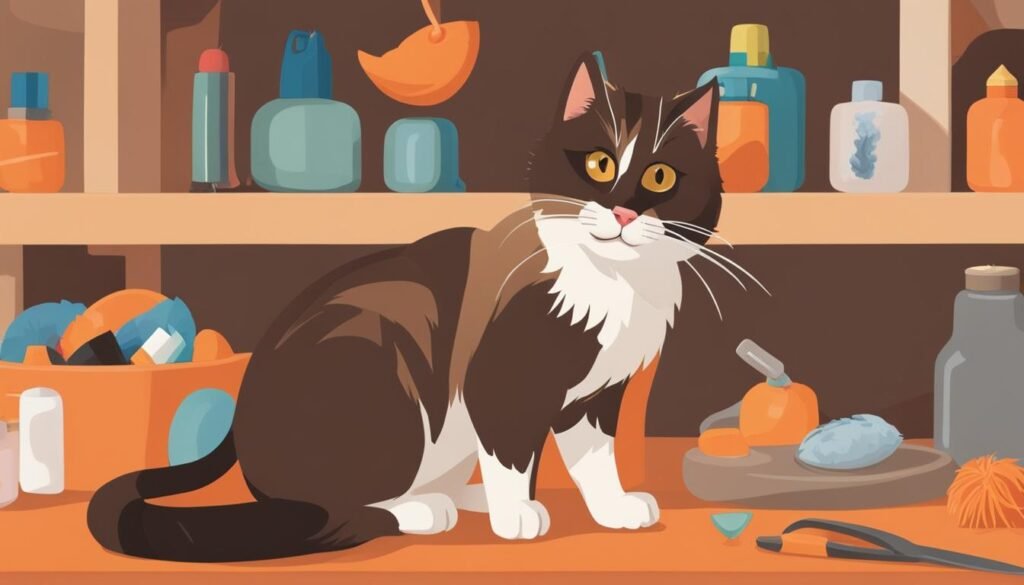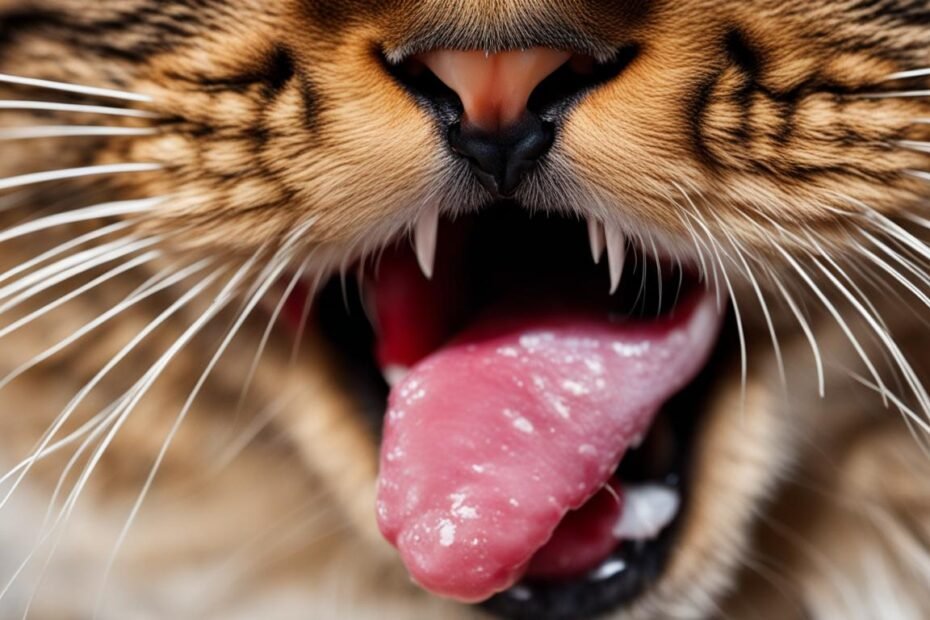Welcome to our comprehensive guide on recognizing cat hairball symptoms. Hairballs in cats are a common issue that can affect their health and well-being. It’s important for cat owners to be able to identify the symptoms of hairballs to ensure timely veterinary care. In this guide, we will discuss the causes of hairballs, their potential risks, and how to prevent and treat them. Let’s dive in and learn more about cat hairball symptoms!
Key Takeaways:
- Cat hairballs form when cats groom themselves and swallow loose and dead hair.
- Long-haired breeds and cats that shed a lot or groom compulsively are more prone to hairballs.
- Common symptoms of cat hairballs include hacking, gagging, vomiting, lack of appetite, and lethargy.
- Preventive measures like regular grooming, specialized hairball-formulated food, and increased fiber intake can help reduce hairball occurrence.
- In severe cases, hairballs can lead to gastrointestinal blockages that may require surgical removal.
Causes of Cat Hairballs
Understanding the causes of cat hairballs is crucial in managing and preventing these unpleasant occurrences. Hairballs form as a result of cats’ grooming routine, which involves licking their fur to keep it clean and groomed. During grooming, their tongues catch loose and dead hair, which is then swallowed. While most of the hair passes through the digestive tract, some can accumulate in the stomach and form a hairball.
Several factors can contribute to the formation of hairballs in cats. Long-haired breeds like Persians and Maine Coons are more prone to hairballs due to the length of their fur, which increases the chances of hair being ingested during grooming. Cats that shed a lot or engage in excessive grooming behavior, such as constant licking or chewing, also have a higher risk of developing hairballs. Additionally, as cats grow older and become more proficient at grooming, their likelihood of developing hairballs increases.
To summarize, the primary causes of cat hairballs include:
- Grooming routine that involves swallowing hair
- Long-haired breeds with increased hair length
- Cats that shed a lot or groom excessively
“Hairballs form as a result of cats’ grooming routine, which involves licking their fur to keep it clean and groomed.”
By understanding the causes of cat hairballs, cat owners can take appropriate preventive measures to reduce the frequency of hairball formation and ensure their feline companions’ well-being.
Recognizing Cat Hairball Symptoms
As a cat owner, it’s important to be able to recognize the symptoms of cat hairballs. Identifying these symptoms can help you provide timely care to your feline friend and ensure their wellbeing. Common signs of hairballs include hacking, gagging, and retching, which are often followed by the expulsion of the hairball through vomiting. However, if your cat experiences persistent vomiting, gagging, retching, or hacking without producing a hairball, it could indicate a more serious issue such as an intestinal blockage.
In addition to hacking and vomiting, there are other symptoms that may suggest the presence of hairballs in your cat. If you notice that your cat has a lack of appetite or seems lethargic, it could be a sign that they are dealing with hairballs. Digestive issues such as constipation or diarrhea can also be indicative of hairballs. It’s essential to monitor your cat’s behavior and seek veterinary attention if any of these symptoms persist or worsen.

Regular observation and attention to your cat’s behavior can help you catch the early signs of hairballs. By promptly seeking veterinary care and treatment, you can prevent potential complications associated with hairballs and ensure your cat’s overall health and happiness.
Preventing Cat Hairballs
Cat hairballs can be a nuisance, but there are steps you can take to reduce their frequency and keep your furry friend healthy. Here are some effective ways to prevent hairballs:
Regular Grooming
Regular grooming is essential for preventing hairballs. By brushing your cat’s fur regularly, you can remove loose hair and prevent excessive hair ingestion during grooming sessions. Focus on areas where your cat is more likely to develop mats or tangles, such as the belly and tail. Regular grooming not only reduces the amount of hair your cat ingests but also helps keep their coat clean and healthy.
Hairball Formulated Food
Consider feeding your cat a specialized hairball-formulated cat food. These foods are designed to contain increased amounts of fiber, which aids in the passage of hair through the digestive system. The fiber helps bind the hair and moves it through the intestines more efficiently, reducing the likelihood of hairball formation. Consult with your veterinarian to find the best hairball-formulated food for your cat’s specific needs.
Increased Fiber Intake
In addition to hairball-formulated food, you can increase your cat’s fiber intake by adding natural fiber sources to their diet. Pumpkin or apple can be mixed into their food to provide extra fiber, which can help move hair through the digestive tract. Just be sure to introduce any dietary changes gradually, and monitor your cat’s response to ensure they tolerate the added fiber well.
Hairball Products and Lubricants
There are various hairball products and lubricants available that can help prevent hairball formation. These products usually come in the form of treats, gels, or pastes and work by lubricating the digestive tract, making it easier for hair to pass through. Some also contain ingredients that help reduce shedding and promote a healthy coat. Consult with your veterinarian to determine which hairball product or lubricant is suitable for your cat.
Remember, preventing hairballs requires a combination of strategies, including regular grooming, a specialized diet, increased fiber intake, and the use of hairball products. By taking these proactive steps, you can minimize the occurrence of hairballs and help your feline friend stay happy and healthy.
Treating Cat Hairballs
Hairballs in cats can usually be managed through preventive measures and home remedies. However, in rare cases, hairballs may lead to more serious health issues, such as gastrointestinal blockages, that require medical intervention. If a cat shows signs of excessive overgrooming, a bloated abdomen, or is unable to vomit or defecate, immediate veterinary attention is necessary to prevent complications and ensure the cat’s well-being.
In situations where hairballs have caused gastrointestinal blockages, surgical removal may be necessary. This procedure involves removing the blockage from the cat’s digestive tract to restore normal function. It is important to consult with a veterinarian to determine the best course of action for your cat’s specific situation.
“In rare cases, hairballs may lead to more serious health issues, such as gastrointestinal blockages, that require medical intervention.”
It is worth noting that surgical removal of hairballs is typically a last resort and is not commonly needed. Taking preventive measures, such as regular grooming, providing a hairball-formulated diet, and promoting hair passage through increased fiber intake, can significantly reduce the occurrence of hairballs and the need for surgical intervention.
By being proactive in recognizing and managing hairballs in cats, owners can help ensure the health and well-being of their feline companions. Regular veterinary check-ups, a balanced diet, and a comfortable grooming routine can go a long way in preventing and addressing hairball issues. It is always best to consult with a veterinarian for personalized advice and guidance.

Treating Cat Hairballs – Key Points:
- Excessive overgrooming, a bloated abdomen, or an inability to vomit or defecate may indicate a gastrointestinal blockage and require immediate veterinary attention.
- Surgical removal of hairballs is a rare procedure and is typically reserved for severe cases with gastrointestinal blockages.
- Preventive measures, such as regular grooming, specialized hairball-formulated diets, and increased fiber intake, can help reduce the occurrence of hairballs.
- Consulting with a veterinarian is essential to determine the best treatment plan for your cat’s specific needs.
Table: Common Symptoms of Gastrointestinal Blockage Caused by Hairballs
| Symptom | Description |
|---|---|
| Excessive Overgrooming | Cat excessively licking or biting their fur |
| Bloated Abdomen | Swollen or distended belly |
| Inability to Vomit or Defecate | Cat is experiencing difficulty or inability to vomit or have a bowel movement |
Dietary Considerations for Hairball Prevention
When it comes to preventing hairballs in cats, a well-balanced diet plays a crucial role. Choosing the right food can help minimize hairball formation and promote healthy digestion. Consider incorporating high-fiber compositions into your cat’s diet, such as psyllium or cellulose fiber. These fibers act as natural laxatives, aiding in the removal of ingested hair and facilitating its passage through the digestive tract. Look for cat food formulated specifically for hairballs, as they often contain these beneficial fibers.
In addition to high-fiber food, pay attention to your cat’s overall nutrition. A diet that supports skin and coat health can reduce excessive shedding, minimizing the amount of hair that your cat ingests during grooming. Look for cat food rich in essential fatty acids, such as omega-3 and omega-6, as these nutrients contribute to a healthy coat and can help prevent excessive hair loss.
“Proper nutrition is key to preventing hairballs in cats. By providing a balanced diet that includes high-fiber compositions and essential fatty acids, you can support your cat’s overall health and minimize the risk of hairball formation.”
It’s also important to ensure that your cat stays hydrated. Adequate water intake can help lubricate the digestive tract, making it easier for hairballs to pass through. Consider providing multiple sources of fresh water throughout your home and try using a drinking fountain to encourage your cat to drink more.
While proper nutrition is essential for hairball prevention, it’s always a good idea to consult with your veterinarian before making any dietary changes. They can provide personalized recommendations based on your cat’s specific needs and health concerns. With the right diet and care, you can help keep your furry friend happy, healthy, and hairball-free.
| Dietary Considerations for Hairball Prevention | Benefits |
|---|---|
| High-fiber compositions (psyllium or cellulose fiber) | Aids in the removal of ingested hair and promotes hairball passage through the digestive tract |
| Food rich in essential fatty acids (omega-3 and omega-6) | Supports skin and coat health, reducing excessive shedding |
| Adequate water intake | Lubricates the digestive tract and facilitates hairball elimination |
Expert Tip: Maintaining a Hairball-Preventive Diet
Dr. Linda Wilson, a renowned veterinarian, emphasizes the importance of a hairball-preventive diet. She recommends incorporating a combination of high-fiber food and essential fatty acids into your cat’s meals. According to Dr. Wilson, “A diet rich in fiber helps move hair through the digestive tract, while essential fatty acids contribute to a healthy coat and reduce shedding. These dietary considerations, coupled with proper hydration, can significantly reduce hairball issues in cats.”
- Provide your cat with balanced, high-fiber cat food formulated for hairball prevention.
- Choose cat food containing essential fatty acids, such as salmon oil or flaxseed oil.
- Ensure your cat has access to fresh water at all times and encourage regular hydration.
- Consult with your veterinarian to determine the best diet for your cat’s specific needs.
Remember, prevention is key when it comes to hairballs. By making dietary considerations and providing optimal nutrition, you can help minimize your cat’s discomfort and improve their overall well-being.
Conclusion
In conclusion, recognizing and addressing cat hairball symptoms is essential for maintaining the health and well-being of our feline companions. By understanding the causes and symptoms of hairballs, cat owners can take proactive measures to prevent potential complications.
Regular grooming, including brushing and combing, helps to remove loose fur and minimize hair ingestion. Specialized hairball-formulated cat food with increased fiber content aids in the natural passage of hair through the digestive system. Additionally, incorporating extra fiber into a cat’s diet, such as pumpkin or apples, can further reduce the risk of hairball formation.
While most hairballs can be managed through preventive measures and home remedies, it’s important to seek veterinary attention if a cat exhibits severe symptoms or experiences gastrointestinal blockages. Prompt treatment can prevent further complications and ensure the well-being of our furry friends.
By implementing these preventive measures and maintaining a proactive approach, cat owners can help their beloved pets lead a hairball-free and healthy life.
FAQ
What are the symptoms of cat hairballs?
Common symptoms include hacking, gagging, retching, and vomiting of the hairball. Other symptoms may include lack of appetite, lethargy, constipation, and diarrhea.
What causes cat hairballs?
Cat hairballs are caused by cats grooming themselves and swallowing loose and dead hair. Long-haired breeds, excessive shedding, and compulsive grooming can increase the risk of hairballs.
How can cat hairballs be prevented?
Preventive measures include regular grooming, feeding hairball-formulated cat food, increasing fiber intake, using hairball products, discouraging excessive grooming, increasing water intake, and lubricating the digestive tract.
How are cat hairballs treated?
In most cases, hairballs can be managed through home remedies. However, in severe cases or if hairballs lead to gastrointestinal blockages, veterinary attention may be necessary, including potential surgical removal.
Are there any dietary considerations for preventing cat hairballs?
Yes, specialized hairball-formulated cat food containing high-fiber compositions like psyllium or cellulose fiber can help remove hair from the stomach and promote its passage through the digestive tract. A balanced diet that supports skin and coat health can also reduce excessive shedding and hair ingestion.
